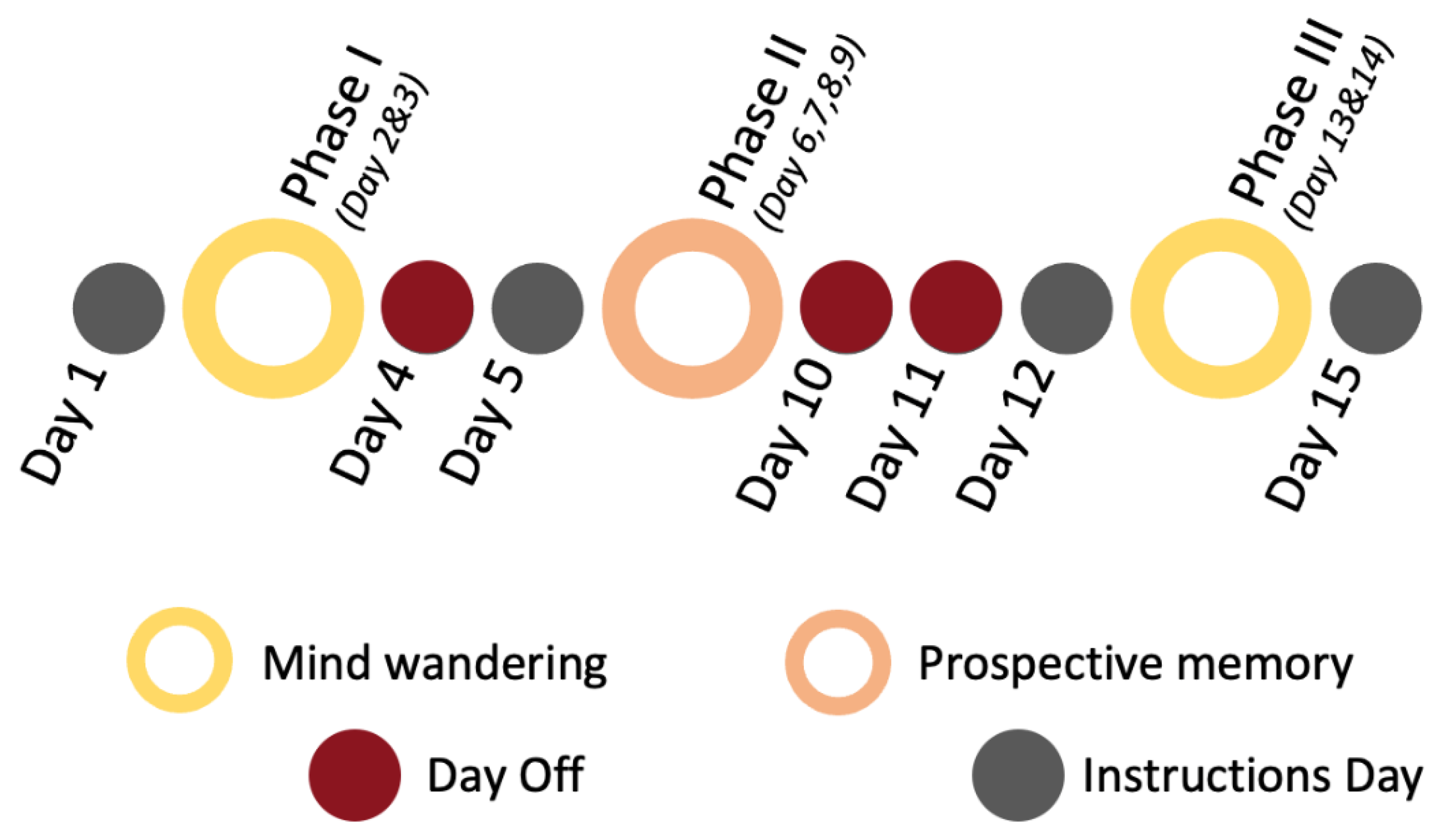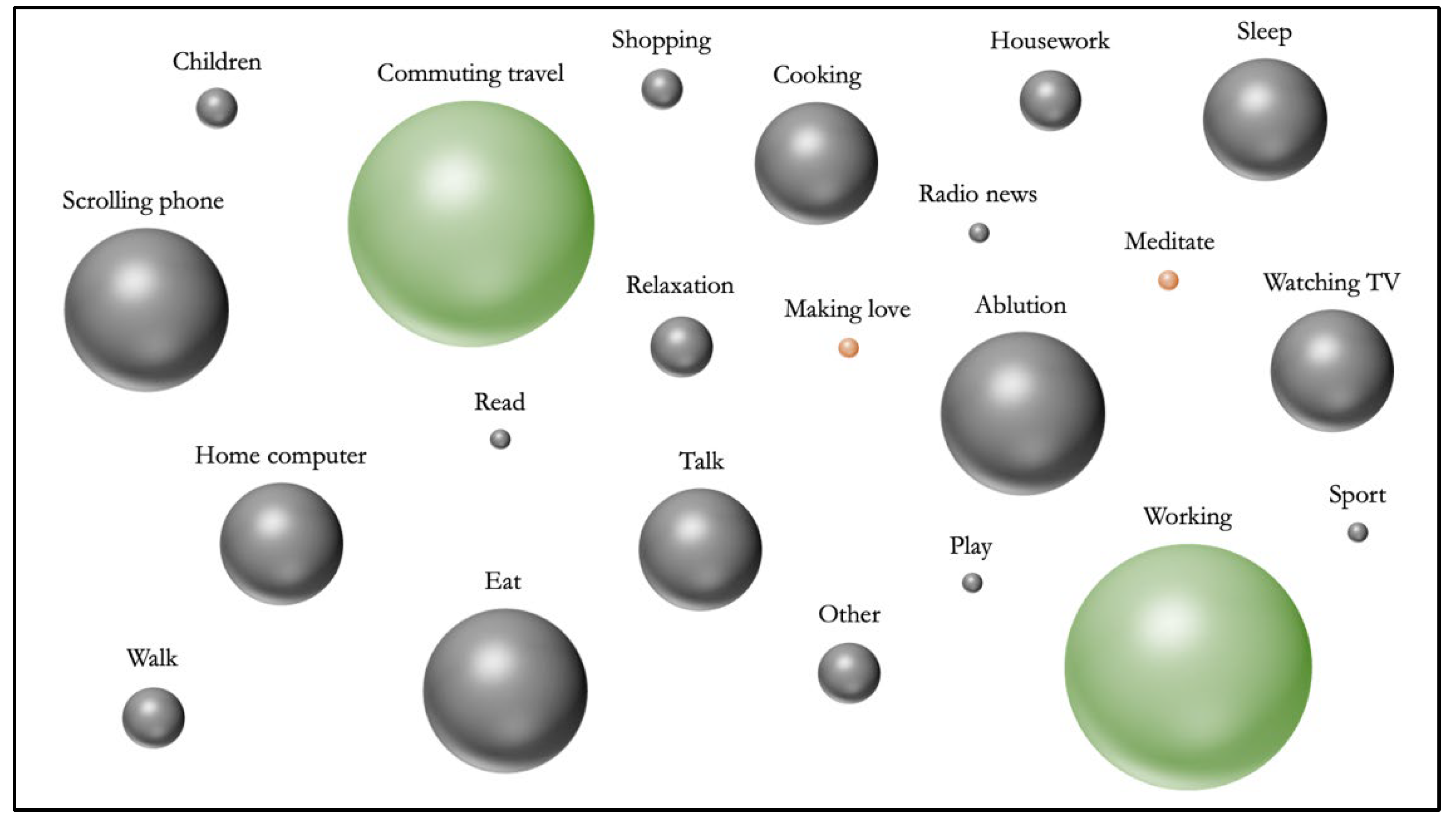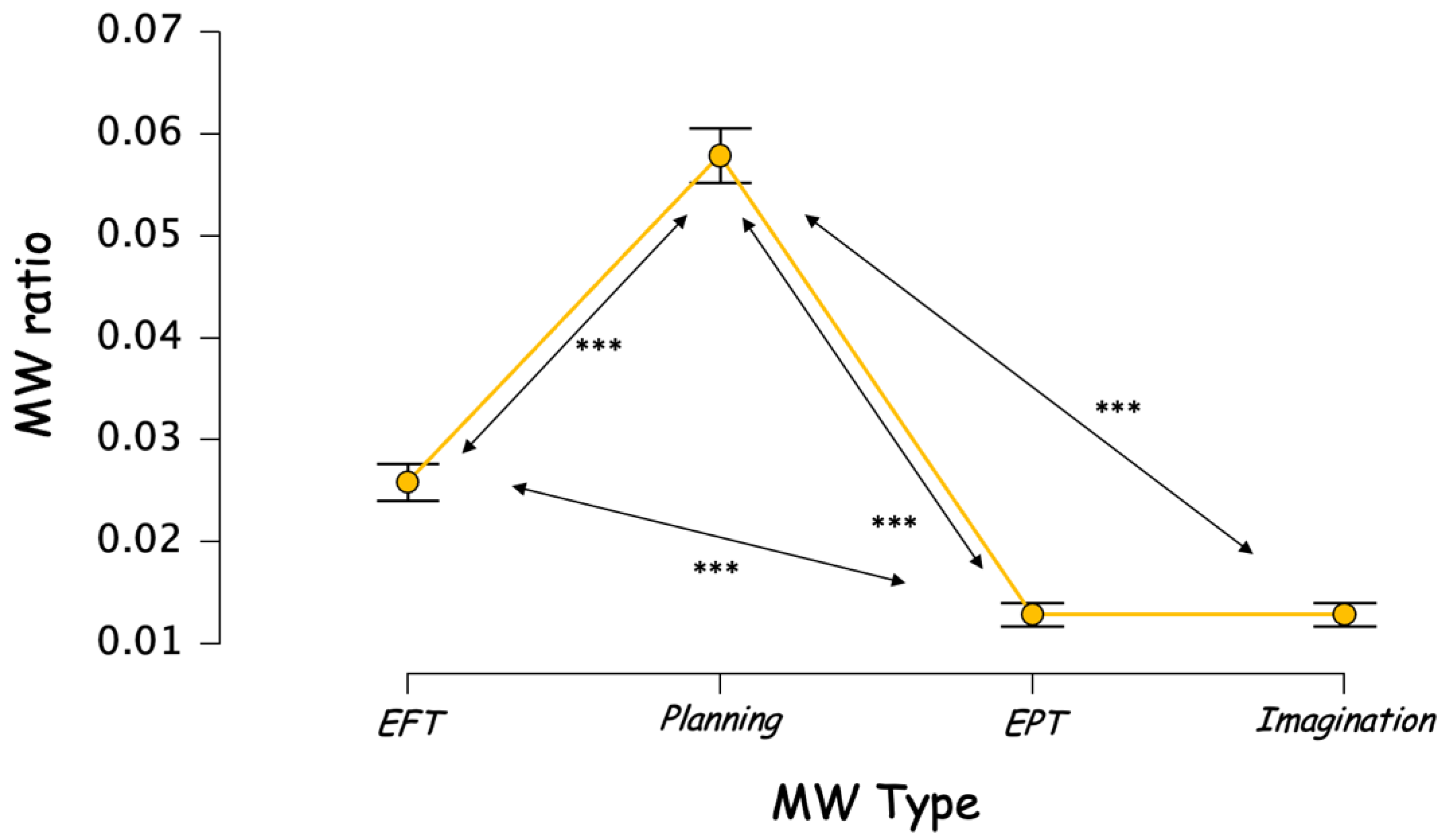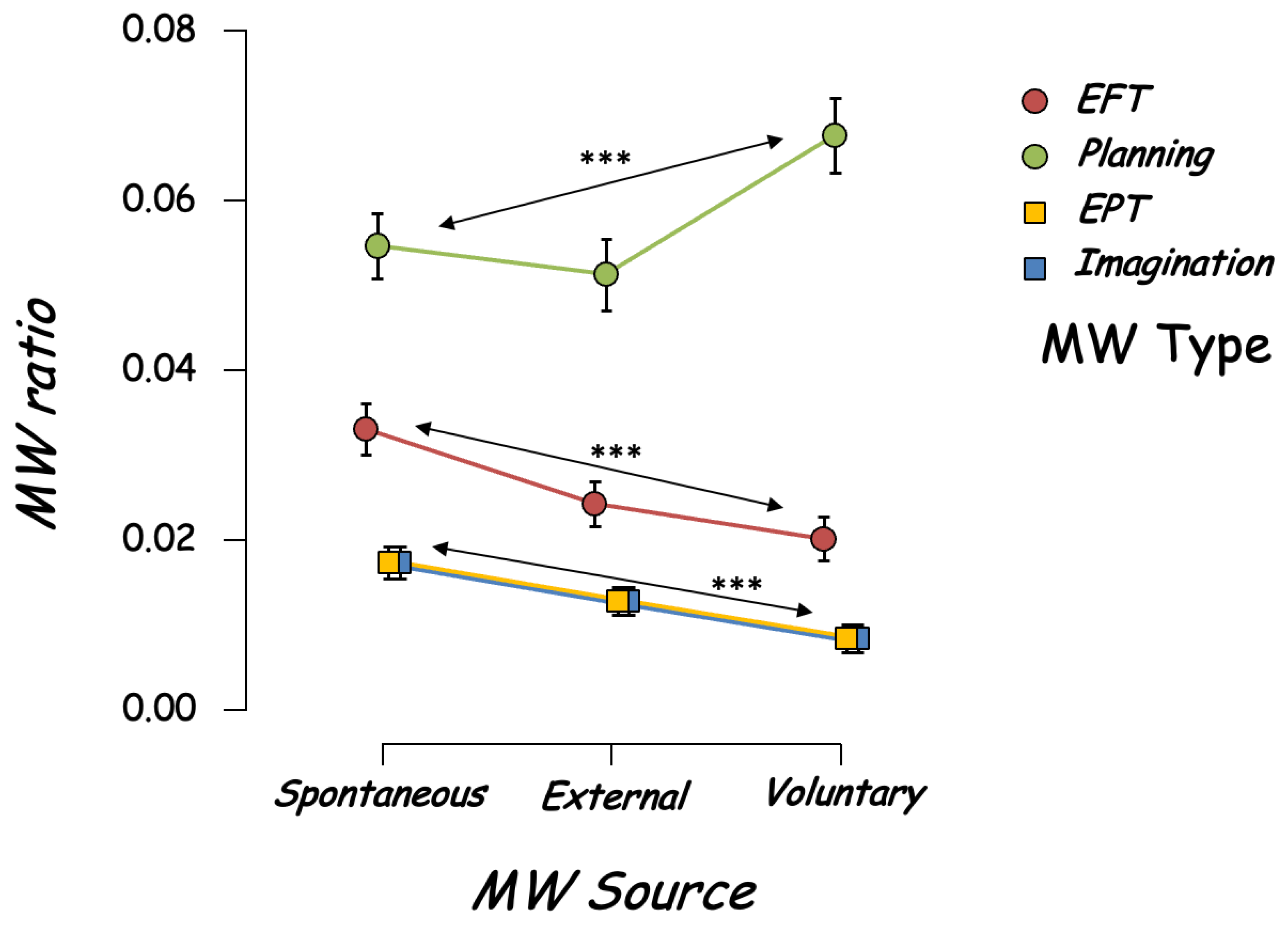Where Is My Mind…? The Link between Mind Wandering and Prospective Memory
Abstract
:1. Introduction
2. Materials and Methods
2.1. Procedure
2.1.1. Participants
2.1.2. Materials
2.2. Overall Conduct
2.3. Experience Sampling
2.3.1. Mind Wandering Assessment
2.3.2. Prospective Memory Assessment
2.3.3. Questionnaires
2.4. Data Analysis
3. Results
3.1. Consistency of Mind Wandering’s Measure
3.2. Consistency of Prospective Memory’s Measure
3.3. Predictors of PM Correct Ratio
4. Discussion
4.1. Validation of the Mind Wandering’s Experimental Protocol
4.2. Validation of the Prospective Memory’s Experimental Protocol
4.3. Investigating the Link between MW and MP
5. Conclusions
Supplementary Materials
Author Contributions
Funding
Institutional Review Board Statement
Informed Consent Statement
Data Availability Statement
Acknowledgments
Conflicts of Interest
References
- Callard, F.; Smallwood, J.; Golchert, J.; Margulies, D.S. The Era of the Wandering Mind? Twenty-First Century Research on Self-Generated Mental Activity. Front. Psychol. 2013, 4, 891. [Google Scholar] [CrossRef] [PubMed]
- Smallwood, J.; Schooler, J.W. The Restless Mind. Psychol. Bull. 2006, 132, 946–958. [Google Scholar] [CrossRef] [PubMed]
- Kane, M.J.; Brown, L.H.; McVay, J.C.; Silvia, P.J.; Myin-Germeys, I.; Kwapil, T.R. For Whom the Mind Wanders, and When: An Experience-Sampling Study of Working Memory and Executive Control in Daily Life. Psychol. Sci. 2007, 18, 614–621. [Google Scholar] [CrossRef] [PubMed]
- Killingsworth, M.A.; Gilbert, D.T. A Wandering Mind Is an Unhappy Mind. Science 2010, 330, 932. [Google Scholar] [CrossRef]
- McVay, J.C.; Kane, M.J.; Kwapil, T.R. Tracking the Train of Thought from the Laboratory into Everyday Life: An Experience-Sampling Study of Mind Wandering across Controlled and Ecological Contexts. Psychon. Bull. Rev. 2009, 16, 857–863. [Google Scholar] [CrossRef]
- Schooler, J.W.; Smallwood, J.; Christoff, K.; Handy, T.C.; Reichle, E.D.; Sayette, M.A. Meta-Awareness, Perceptual Decoupling and the Wandering Mind. Trends Cogn. Sci. 2011, 15, 319–326. [Google Scholar] [CrossRef]
- Seli, P.; Kane, M.J.; Metzinger, T.; Smallwood, J.; Schacter, D.L.; Maillet, D.; Schooler, J.W.; Smilek, D. The Family-Resemblances Framework for Mind-Wandering Remains Well Clad. Trends Cogn. Sci. 2018, 22, 959–961. [Google Scholar] [CrossRef]
- Christoff, K.; Mills, C.; Andrews-Hanna, J.R.; Irving, Z.C.; Thompson, E.; Fox, K.C.R.; Kam, J.W.Y. Mind-Wandering as a Scientific Concept: Cutting through the Definitional Haze. Trends Cogn. Sci. 2018, 22, 957–959. [Google Scholar] [CrossRef]
- Seli, P.; Kane, M.J.; Smallwood, J.; Schacter, D.L.; Maillet, D.; Schooler, J.W.; Smilek, D. Mind-Wandering as a Natural Kind: A Family-Resemblances View. Trends Cogn. Sci. 2018, 22, 479–490. [Google Scholar] [CrossRef]
- Giambra, L.M. Task-Unrelated-Thought Frequency as a Function of Age: A Laboratory Study. Psychol. Aging 1989, 4, 136–143. [Google Scholar] [CrossRef]
- Antrobus, J.S. Information Theory and Stimulus-Independent Thought. Br. J. Psychol. 1968, 59, 423–430. [Google Scholar] [CrossRef]
- Stawarczyk, D.; Majerus, S.; Maj, M.; Van der Linden, M.; D’Argembeau, A. Mind-Wandering: Phenomenology and Function as Assessed with a Novel Experience Sampling Method. Acta Psychol. 2011, 136, 370–381. [Google Scholar] [CrossRef]
- Christoff, K.; Irving, Z.C.; Fox, K.C.R.; Spreng, R.N.; Andrews-Hanna, J.R. Mind-Wandering as Spontaneous Thought: A Dynamic Framework. Nat. Rev. Neurosci. 2016, 17, 718–731. [Google Scholar] [CrossRef]
- Carriere, J.S.A.; Seli, P.; Smilek, D. Wandering in Both Mind and Body: Individual Differences in Mind Wandering and Inattention Predict Fidgeting. Can. J. Exp. Psychol. 2013, 67, 19–31. [Google Scholar] [CrossRef]
- Seli, P.; Risko, E.F.; Smilek, D.; Schacter, D.L. Mind-Wandering with and Without Intention. Trends Cogn. Sci. 2016, 20, 605–617. [Google Scholar] [CrossRef]
- McVay, J.C.; Kane, M.J. Does Mind Wandering Reflect Executive Function or Executive Failure? Comment on Smallwood and Schooler (2006) and Watkins (2008). Psychol. Bull. 2010, 136, 188–197. [Google Scholar] [CrossRef]
- Chiorri, C.; Vannucci, M. Replicability of the Psychometric Properties of Trait-Levels Measures of Spontaneous and Deliberate Mind Wandering. Eur. J. Psychol. Assess. 2019, 35, 459–468. [Google Scholar] [CrossRef]
- Vannucci, M.; Chiorri, C.; Nocentini, A.; Menesini, E. Distinguishing Spontaneous from Deliberate Mind Wandering in Adolescents: The Role of Attentional Control and Depressive Symptoms. Br. J. Dev. Psychol. 2020, 38, 434–441. [Google Scholar] [CrossRef]
- Robison, M.K.; Unsworth, N. Cognitive and Contextual Correlates of Spontaneous and Deliberate Mind-Wandering. J. Exp. Psychol. Learn. Mem. Cogn. 2017, 44, 85–98. [Google Scholar] [CrossRef]
- Seli, P.; Cheyne, J.A.; Xu, M.; Purdon, C.; Smilek, D. Motivation, Intentionality, and Mind Wandering: Implications for Assessments of Task-Unrelated Thought. J. Exp. Psychol. Learn. Mem. Cogn. 2015, 41, 1417–1425. [Google Scholar] [CrossRef]
- Mooneyham, B.W.; Schooler, J.W. The Costs and Benefits of Mind-Wandering: A Review. Can. J. Exp. Psychol. 2013, 67, 11–18. [Google Scholar] [CrossRef]
- Smallwood, J.; Schooler, J.W. The Science of Mind Wandering: Empirically Navigating the Stream of Consciousness. Annu. Rev. Psychol. 2015, 66, 487–518. [Google Scholar] [CrossRef]
- Randall, J.G.; Oswald, F.L.; Beier, M.E. Mind-Wandering, Cognition, and Performance: A Theory-Driven Meta-Analysis of Attention Regulation. Psychol. Bull. 2014, 140, 1411–1431. [Google Scholar] [CrossRef]
- Kam, J.W.Y.; Handy, T.C. The Neurocognitive Consequences of the Wandering Mind: A Mechanistic Account of Sensory-Motor Decoupling. Front. Psychol. 2013, 4, 1–13. [Google Scholar] [CrossRef]
- McVay, J.C.; Kane, M.J. Conducting the Train of Thought: Working Memory Capacity, Goal Neglect, and Mind Wandering in an Executive-Control Task. J. Exp. Psychol. Learn. Mem. Cogn. 2009, 35, 196–204. [Google Scholar] [CrossRef]
- Thomson, D.R.; Besner, D.; Smilek, D. A Resource-Control Account of Sustained Attention. Perspect. Psychol. Sci. 2015, 10, 82–96. [Google Scholar] [CrossRef]
- Unsworth, N.; Robison, M.K. The Influence of Lapses of Attention on Working Memory Capacity. Mem. Cognit. 2016, 44, 188–196. [Google Scholar] [CrossRef]
- Mrazek, M.D.; Smallwood, J.; Franklin, M.S.; Chin, J.M.; Baird, B.; Schooler, J.W. The Role of Mind-Wandering in Measurements of General Aptitude. J. Exp. Psychol. Gen. 2012, 141, 788–798. [Google Scholar] [CrossRef]
- Blondé, P.; Girardeau, J.-C.; Sperduti, M.; Piolino, P. A Wandering Mind Is a Forgetful Mind: A Systematic Review on the Influence of Mind Wandering on Episodic Memory Encoding. Neurosci. Biobehav. Rev. 2022, 132, 774–792. [Google Scholar] [CrossRef]
- Wammes, J.D.; Seli, P.; Cheyne, J.A.; Boucher, P.O.; Smilek, D. Mind Wandering during Lectures II: Relation to Academic Performance. Scholarsh. Teach. Learn. Psychol. 2016, 2, 33–48. [Google Scholar] [CrossRef]
- Maillet, D.; Seli, P.; Schacter, D.L. Mind-Wandering and Task Stimuli: Stimulus-Dependent Thoughts Influence Performance on Memory Tasks and Are More Often Past- versus Future-Oriented. Conscious. Cogn. 2017, 52, 55–67. [Google Scholar] [CrossRef] [PubMed]
- Maillet, D.; Schacter, D.L. When the Mind Wanders: Distinguishing Stimulus-Dependent from Stimulus-Independent Thoughts during Incidental Encoding in Young and Older Adults. Psychol. Aging 2016, 31, 370–379. [Google Scholar] [CrossRef] [PubMed]
- Nadel, L.; Hupbach, A.; Gomez, R.; Newman-Smith, K. Memory Formation, Consolidation and Transformation. Neurosci. Biobehav. Rev. 2012, 36, 1640–1645. [Google Scholar] [CrossRef] [PubMed]
- Alberini, C.M.; LeDoux, J.E. Memory Reconsolidation. Curr. Biol. 2013, 23, R746–R750. [Google Scholar] [CrossRef] [PubMed]
- Mills, C.; Herrera-Bennett, A.; Faber, M.; Christoff, K. Why the Mind Wanders: How Spontaneous Thought’s Default Variability May Support Episodic Efficiency and Semantic Optimization. In The Oxford Handbook of Spontaneous Thought: Mind-Wandering, Creativity and Dreaming; Oxford University Press: Oxford, UK, 2018; pp. 11–22. [Google Scholar] [CrossRef]
- Baird, B.; Smallwood, J.; Schooler, J.W. Back to the Future: Autobiographical Planning and the Functionality of Mind-Wandering. Conscious. Cogn. 2011, 20, 1604–1611. [Google Scholar] [CrossRef] [PubMed]
- Kvavilashvili, L.; Rummel, J. On the Nature of Everyday Prospection: A Review and Theoretical Integration of Research on Mind-Wandering, Future Thinking, and Prospective Memory. Rev. Gen. Psychol. 2020, 24, 210–237. [Google Scholar] [CrossRef]
- Klinger, E. Thought Flow: Properties and Mechanisms Underlying Shifts in Content. In At Play in Fields of Consciousness: Essays in Honor of Jerome L. Singer; Lawrence Eribaum Associations Publishers: Mahwah, NJ, USA, 1999; pp. 29–50. [Google Scholar]
- Medea, B.; Karapanagiotidis, T.; Konishi, M.; Ottaviani, C.; Margulies, D.; Bernasconi, A.; Bernasconi, N.; Bernhardt, B.C.; Jefferies, E.; Smallwood, J. How Do We Decide What to Do? Resting-State Connectivity Patterns and Components of Self-Generated Thought Linked to the Development of More Concrete Personal Goals. Exp. Brain Res. 2018, 236, 2469–2481. [Google Scholar] [CrossRef] [PubMed]
- Einstein, G.O.; McDaniel, M.A. Normal Aging and Prospective Memory. J. Exp. Psychol. Learn. Mem. Cogn. 1990, 16, 717–726. [Google Scholar] [CrossRef]
- Kalpouzos, G.; Eustache, F.; Desgranges, B. La mémoire prospective au cours du vieillissement: Déclin ou préservation ? NPG Neurol.-Psychiatr. Gériatrie 2008, 8, 25–31. [Google Scholar] [CrossRef]
- McDaniel, M.A.; Einstein, G.O. Strategic and Automatic Processes in Prospective Memory Retrieval: A Multiprocess Framework. Appl. Cogn. Psychol. 2000, 14, S127–S144. [Google Scholar] [CrossRef]
- Chen, X.; Wang, Y.; Liu, L.; Cui, J.; Gan, M.; Shum, D.H.K.; Chan, R.C.K. The Effect of Implementation Intention on Prospective Memory: A Systematic and Meta-Analytic Review. Psychiatry Res. 2015, 226, 14–22. [Google Scholar] [CrossRef]
- Gonneaud, J.; Kalpouzos, G.; Bon, L.; Viader, F.; Eustache, F.; Desgranges, B. Distinct and Shared Cognitive Functions Mediate Event- and Time-Based Prospective Memory Impairment in Normal Ageing. Memory 2011, 19, 360–377. [Google Scholar] [CrossRef]
- Martin, M.; Kliegel, M.; McDaniel, M.A. The Involvement of Executive Functions in Prospective Memory Performance of Adults. Int. J. Psychol. 2003, 38, 195–206. [Google Scholar] [CrossRef]
- Rose, N.S.; Rendell, P.G.; Hering, A.; Kliegel, M.; Bidelman, G.M.; Craik, F.I.M. Cognitive and Neural Plasticity in Older Adults’ Prospective Memory Following Training with the Virtual Week Computer Game. Front. Hum. Neurosci. 2015, 9, 592. [Google Scholar] [CrossRef]
- Schnitzspahn, K.M.; Stahl, C.; Zeintl, M.; Kaller, C.P.; Kliegel, M. The Role of Shifting, Updating, and Inhibition in Prospective Memory Performance in Young and Older Adults. Dev. Psychol. 2013, 49, 1544–1553. [Google Scholar] [CrossRef]
- Smith, R.E. The Cost of Remembering to Remember in Event-Based Prospective Memory: Investigating the Capacity Demands of Delayed Intention Performance. J. Exp. Psychol. Learn. Mem. Cogn. 2003, 29, 347–361. [Google Scholar] [CrossRef]
- Rouleau, I.; Lajeunesse, A.; Drolet, V.; Potvin, M.-J.; Marcone, S.; Lecomte, S.; Imbeault, H.; Limoges, F.; Labelle, V.; Gagnon, J.-F.; et al. L’évaluation clinique de la mémoire prospective dans le MCI. NPG Neurol. Psychiatr. Gériatrie 2016, 16, 152–158. [Google Scholar] [CrossRef]
- Logie, R.H.; Law, A.; Trawley, S.; Nissan, J. Multitasking, Working Memory and Remembering Intentions. Psychol. Belg. 2010, 50, 309. [Google Scholar] [CrossRef]
- Shallice, T.; Burgess, P.W. Deficits in strategy application following frontal lobe damagein man. Brain 1991, 114, 727–741. [Google Scholar] [CrossRef]
- Rummel, J.; McDaniel, M.A. (Eds.) Prospective Memory; Routledge: Abingdon, UK; New York, NY, USA, 2019; ISBN 978-1-138-54580-9. [Google Scholar]
- Scullin, M.K.; McDaniel, M.A.; Shelton, J.T. The Dynamic Multiprocess Framework: Evidence from Prospective Memory with Contextual Variability. Cognit. Psychol. 2013, 67, 55–71. [Google Scholar] [CrossRef]
- Einstein, G.O.; McDaniel, M.A. Prospective Memory: Multiple Retrieval Processes. Curr. Dir. Psychol. Sci. 2005, 14, 286–290. [Google Scholar] [CrossRef]
- Seli, P.; Smilek, D.; Ralph, B.C.W.; Schacter, D.L. The Awakening of the Attention: Evidence for a Link between the Monitoring of Mind Wandering and Prospective Goals. J. Exp. Psychol. Gen. 2018, 147, 431–443. [Google Scholar] [CrossRef]
- Girardeau, J.-C.; Blondé, P.; Makowski, D.; Abram, M.; Piolino, P.; Sperduti, M. The Impact of State and Dispositional Mindfulness on Prospective Memory: A Virtual Reality Study. Conscious. Cogn. 2020, 81, 102920. [Google Scholar] [CrossRef]
- Schooler, J.W. Re-Representing Consciousness: Dissociations between Experience and Meta-Consciousness. Trends Cogn. Sci. 2002, 6, 339–344. [Google Scholar] [CrossRef]
- Thadeus Meeks, J.; Hicks, J.L.; Marsh, R.L. Metacognitive Awareness of Event-Based Prospective Memory. Conscious. Cogn. 2007, 16, 997–1004. [Google Scholar] [CrossRef]
- Anderson, F.T.; McDaniel, M.A. Hey Buddy, Why Don’t We Take It Outside: An Experience Sampling Study of Prospective Memory. Mem. Cognit. 2019, 47, 47–62. [Google Scholar] [CrossRef]
- Rummel, J.; Smeekens, B.A.; Kane, M.J. Dealing with Prospective Memory Demands While Performing an Ongoing Task: Shared Processing, Increased on-Task Focus, or Both? J. Exp. Psychol. Learn. Mem. Cogn. 2017, 43, 1047–1062. [Google Scholar] [CrossRef]
- Christoff, K.; Gordon, A.M.; Smallwood, J.; Smith, R.; Schooler, J.W. Experience Sampling during FMRI Reveals Default Network and Executive System Contributions to Mind Wandering. Proc. Natl. Acad. Sci. USA 2009, 106, 8719–8724. [Google Scholar] [CrossRef] [PubMed]
- Song, X.; Wang, X. Mind Wandering in Chinese Daily Lives—An Experience Sampling Study. PLoS ONE 2012, 7, e44423. [Google Scholar] [CrossRef] [Green Version]
- Szarras, K.; Niedźwieńska, A. The Role of Rehearsals in Self-Generated Prospective Memory Tasks. Int. J. Psychol. 2011, 46, 346–353. [Google Scholar] [CrossRef]
- Gardner, R.S.; Ascoli, G.A. The Natural Frequency of Human Prospective Memory Increases with Age. Psychol. Aging 2015, 30, 209–219. [Google Scholar] [CrossRef] [PubMed]
- Mason, M.F.; Reinholtz, N. Avenues down Which a Self-Reminding Mind Can Wander. Motiv. Sci. 2015, 1, 1–21. [Google Scholar] [CrossRef]
- Warden, E.A.; Plimpton, B.; Kvavilashvili, L. Absence of Age Effects on Spontaneous Past and Future Thinking in Daily Life. Psychol. Res. 2019, 83, 727–746. [Google Scholar] [CrossRef]
- Zuber, S.; Kliegel, M. Prospective Memory Development Across the Lifespan: An Integrative Framework. Eur. Psychol. 2020, 25, 162–173. [Google Scholar] [CrossRef]
- Rummel, J.; Danner, D.; Kuhlmann, B.G. The Short Version of the Metacognitive Prospective Memory Inventory (MPMI-s): Factor Structure, Reliability, Validity, and Reference Data. Meas. Instrum. Soc. Sci. 2019, 1, 6. [Google Scholar] [CrossRef]
- Kroenke, K.; Spitzer, R.L.; Williams, J.B.W.; Löwe, B. An Ultra-Brief Screening Scale for Anxiety and Depression: The PHQ–4. Psychosomatics 2009, 50, 613–621. [Google Scholar] [CrossRef]
- Löwe, B.; Wahl, I.; Rose, M.; Spitzer, C.; Glaesmer, H.; Wingenfeld, K.; Schneider, A.; Brähler, E. A 4-Item Measure of Depression and Anxiety: Validation and Standardization of the Patient Health Questionnaire-4 (PHQ-4) in the General Population. J. Affect. Disord. 2010, 122, 86–95. [Google Scholar] [CrossRef]
- Deng, Y.-Q.; Li, S.; Tang, Y.-Y. The Relationship Between Wandering Mind, Depression and Mindfulness. Mindfulness 2014, 5, 124–128. [Google Scholar] [CrossRef]
- Hoffmann, F.; Banzhaf, C.; Kanske, P.; Bermpohl, F.; Singer, T. Where the Depressed Mind Wanders: Self-Generated Thought Patterns as Assessed through Experience Sampling as a State Marker of Depression. J. Affect. Disord. 2016, 198, 127–134. [Google Scholar] [CrossRef]
- Marchetti, I.; Koster, E.H.W.; De Raedt, R. Mindwandering Heightens the Accessibility of Negative Relative to Positive Thought. Conscious. Cogn. 2012, 21, 1517–1525. [Google Scholar] [CrossRef]
- Stawarczyk, D.; Cassol, H.; D’Argembeau, A. Phenomenology of Future-Oriented Mind-Wandering Episodes. Front. Psychol. 2013, 4, 425. [Google Scholar] [CrossRef]
- Baumeister, R.F.; Hofmann, W.; Summerville, A.; Reiss, P.T.; Vohs, K.D. Everyday Thoughts in Time: Experience Sampling Studies of Mental Time Travel. Pers. Soc. Psychol. Bull. 2020, 46, 1631–1648. [Google Scholar] [CrossRef]
- Berntsen, D.; Jacobsen, A.S. Involuntary (Spontaneous) Mental Time Travel into the Past and Future. Conscious. Cogn. 2008, 17, 1093–1104. [Google Scholar] [CrossRef]
- D’Argembeau, A.; Renaud, O.; Van der Linden, M. Frequency, Characteristics and Functions of Future-Oriented Thoughts in Daily Life. Appl. Cogn. Psychol. 2011, 25, 96–103. [Google Scholar] [CrossRef]
- Jason, L.A.; Schade, J.; Furo, L.; Reichler, A.; Brickman, C. Time Orientation: Past, Present, and Future Perceptions. Psychol. Rep. 1989, 64, 1199–1205. [Google Scholar] [CrossRef]
- Rummel, J.; Meiser, T. The Role of Metacognition in Prospective Memory: Anticipated Task Demands Influence Attention Allocation Strategies. Conscious. Cogn. 2013, 22, 931–943. [Google Scholar] [CrossRef]
- Smith, R.E. Prospective Memory: A Framework for Research on Metaintentions. In The Oxford Handbook of Metamemory; Oxford Library of Psychology, Oxford University Press: Oxford, UK, 2016; pp. 217–244. ISBN 978-0-19-933674-6. [Google Scholar]
- Meier, B.; von Wartburg, P.; Matter, S.; Rothen, N.; Reber, R. Performance Predictions Improve Prospective Memory and Influence Retrieval Experience. Can. J. Exp. Psychol. 2011, 65, 12–18. [Google Scholar] [CrossRef]
- Smith, S.J.; Souchay, C.; Moulin, C.J.A. Metamemory and Prospective Memory in Parkinson’s Disease. Neuropsychology 2011, 25, 734–740. [Google Scholar] [CrossRef]
- Cole, S.; Kvavilashvili, L. Spontaneous Future Cognition: The Past, Present and Future of an Emerging Topic. Psychol. Res. 2019, 83, 631–650. [Google Scholar] [CrossRef] [Green Version]
- Wammes, J.D.; Boucher, P.O.; Seli, P.; Cheyne, J.A.; Smilek, D. Mind Wandering during Lectures I: Changes in Rates across an Entire Semester. Scholarsh. Teach. Learn. Psychol. 2016, 2, 13–32. [Google Scholar] [CrossRef]
- Mills, C.; Herrera-Bennett, A.; Faber, M.; Christoff, K. Why the Mind Wanders; Christoff, K., Fox, K.C.R., Eds.; Oxford University Press: Oxford, UK, 2018; Volume 1. [Google Scholar]
- Grilli, M.D.; McFarland, C.P. Imagine That: Self-Imagination Improves Prospective Memory in Memory-Impaired Individuals with Neurological Damage. Neuropsychol. Rehabil. 2011, 21, 847–859. [Google Scholar] [CrossRef] [PubMed]
- Potvin, M.-J.; Rouleau, I.; Audy, J.; Charbonneau, S.; Giguère, J.-F. Ecological Prospective Memory Assessment in Patients with Traumatic Brain Injury. Brain Inj. 2011, 25, 192–205. [Google Scholar] [CrossRef] [PubMed]
- Gable, S.L.; Hopper, E.A.; Schooler, J.W. When the Muses Strike: Creative Ideas of Physicists and Writers Routinely Occur During Mind Wandering. Psychol. Sci. 2019, 30, 396–404. [Google Scholar] [CrossRef] [PubMed]
- Preiss, D.D.; Cosmelli, D.; Grau, V.; Ortiz, D. Examining the Influence of Mind Wandering and Metacognition on Creativity in University and Vocational Students. Learn. Individ. Differ. 2016, 51, 417–426. [Google Scholar] [CrossRef]
- Yamaoka, A.; Yukawa, S. Mind Wandering in Creative Problem-Solving: Relationships with Divergent Thinking and Mental Health. PLoS ONE 2020, 15, e0231946. [Google Scholar] [CrossRef]
- Zedelius, C.M.; Schooler, J.W. Mind Wandering “Ahas” versus Mindful Reasoning: Alternative Routes to Creative Solutions. Front. Psychol. 2015, 6, 834. [Google Scholar] [CrossRef]
- Leszczynski, M.; Chaieb, L.; Reber, T.P.; Derner, M.; Axmacher, N.; Fell, J. Mind Wandering Simultaneously Prolongs Reactions and Promotes Creative Incubation. Sci. Rep. 2017, 7, 10197. [Google Scholar] [CrossRef]
- Yamaoka, A.; Yukawa, S. Does Mind Wandering During the Thought Incubation Period Improve Creativity and Worsen Mood? Psychol. Rep. 2020, 123, 1785–1800. [Google Scholar] [CrossRef]
- Smeekens, B.A.; Kane, M.J. Working Memory Capacity, Mind Wandering, and Creative Cognition: An Individual-Differences Investigation Into the Benefits of Controlled Versus Spontaneous Thought. Psychol. Aesthet. Creat. Arts 2016, 10, 389–415. [Google Scholar] [CrossRef]
- Steindorf, L.; Hammerton, H.A.; Rummel, J. Mind Wandering Outside the Box—About the Role of off-Task Thoughts and Their Assessment during Creative Incubation. Psychol. Aesthet. Creat. Arts 2020, 15, 584–595. [Google Scholar] [CrossRef]
- Kvavilashvili, L.; Fisher, L. Is Time-Based Prospective Remembering Mediated by Self-Initiated Rehearsals? Role of Incidental Cues, Ongoing Activity, Age, and Motivation. J. Exp. Psychol. Gen. 2007, 136, 112–132. [Google Scholar] [CrossRef] [PubMed]
- Brewer, G.A.; Marsh, R.L. On the Role of Episodic Future Simulation in Encoding of Prospective Memories. Cogn. Neurosci. 2010, 1, 81–88. [Google Scholar] [CrossRef] [PubMed]
- Seli, P.; Risko, E.F.; Smilek, D. On the Necessity of Distinguishing Between Unintentional and Intentional Mind Wandering. Psychol. Sci. 2016, 27, 685–691. [Google Scholar] [CrossRef] [PubMed]





| TOTAL | FOCUS | MIND WANDERING | |
|---|---|---|---|
| Sent Probes | 5424 | — | — |
| Received Probes | 4465 | 2700 | 1765 |
| Average Probes Answered per participants (24 thought probes possible) | 19.75 ± 3.63 Min–12 Max–24 | 11.95 ± 4.06 | 7.81 ± 3.67 |
| Q1—What were you doing just before you got the message? | Reading, Walking, Houseworking, etc… (23 responses here) |
| Q2—Are you… | At home, At work, Other |
| Q3—Are you… | Alone, With another person, In a group |
| Q4—Were you thinking of anything other than what you were doing? | Yes, No |
| Q5—What were you thinking exactly?conditioned on the answer “Yes” to Q4, otherwise end of survey |
|
| Q6—Did this thought arise while…conditioned on the answer “Planning” to Q5, otherwise end of survey | You just planned this intention/You had already planned this intention |
| Q7—How did this thought come to your mind?conditioned on the answer “Yes” to Q4 |
|
| Q1—How often have you thought about doing this task? | Never/Rarely/Sometimes/Often/Very often |
| Q2—Around what time did you think about it for the first time? | In the awakening/6 a.m./7 a.m./8 a.m./9 a.m./10 a.m./11 a.m./12 p.m./1 p.m./2 p.m./3 p.m./Just before |
| Q3—Around what time did you think about it for the last time? | In the awakening/6 a.m./7 a.m./8 a.m./9 a.m./10 a.m./11 a.m./12 p.m./1 p.m./2 p.m./3 p.m./Just before |
| Q4—How did you remember that you were to complete this task? | Something in my environment caught my attention and made me think about it I thought about it as my mind wandered despite myself Nothing special reminded me of it, I just thought of it spontaneously |
| Q5—Has performing this task become automatic? | Yes/No |
| Activity | Frequency |
|---|---|
| Making love | 0.11% |
| Meditate | 0.23% |
| Play | 0.62% |
| Radio news | 0.74% |
| Sport | 0.96% |
| Read | 0.96% |
| Children | 1.59% |
| Shopping | 1.87% |
| Walk | 3.06% |
| Relaxation | 3.17% |
| Housework | 3.34% |
| Other | 3.91% |
| Cooking | 4.76% |
| Home computer | 5.27% |
| Talk | 5.33% |
| Sleep | 5.84% |
| Watching TV | 5.84% |
| Ablution | 7.31% |
| Scrolling phone | 7.42% |
| Eat | 8.95% |
| Commuting travel | 12.92% |
| Work | 15.81% |
Publisher’s Note: MDPI stays neutral with regard to jurisdictional claims in published maps and institutional affiliations. |
© 2022 by the authors. Licensee MDPI, Basel, Switzerland. This article is an open access article distributed under the terms and conditions of the Creative Commons Attribution (CC BY) license (https://creativecommons.org/licenses/by/4.0/).
Share and Cite
Girardeau, J.-C.; Sperduti, M.; Blondé, P.; Piolino, P. Where Is My Mind…? The Link between Mind Wandering and Prospective Memory. Brain Sci. 2022, 12, 1139. https://doi.org/10.3390/brainsci12091139
Girardeau J-C, Sperduti M, Blondé P, Piolino P. Where Is My Mind…? The Link between Mind Wandering and Prospective Memory. Brain Sciences. 2022; 12(9):1139. https://doi.org/10.3390/brainsci12091139
Chicago/Turabian StyleGirardeau, Jean-Charles, Marco Sperduti, Philippe Blondé, and Pascale Piolino. 2022. "Where Is My Mind…? The Link between Mind Wandering and Prospective Memory" Brain Sciences 12, no. 9: 1139. https://doi.org/10.3390/brainsci12091139
APA StyleGirardeau, J.-C., Sperduti, M., Blondé, P., & Piolino, P. (2022). Where Is My Mind…? The Link between Mind Wandering and Prospective Memory. Brain Sciences, 12(9), 1139. https://doi.org/10.3390/brainsci12091139






